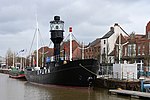Hull Maritime Museum
1872 establishments in England1912 establishments in EnglandGrade II* listed buildings in the East Riding of YorkshireHistory museums in the East Riding of YorkshireIndustrial buildings completed in 1872 ... and 4 more
Maritime museums in EnglandMuseums established in 1912Museums in Kingston upon HullUse British English from December 2013

The Hull Maritime Museum is a museum in Kingston upon Hull, England, that explores the seafaring heritage of the city and its environs. The museum's stated mission is "To preserve and make available the maritime history of Hull and east Yorkshire through artefacts and documents".
Excerpt from the Wikipedia article Hull Maritime Museum (License: CC BY-SA 3.0, Authors, Images).Hull Maritime Museum
King Edward Street, Hull Old Town
Geographical coordinates (GPS) Address External links Nearby Places Show on map
Geographical coordinates (GPS)
| Latitude | Longitude |
|---|---|
| N 53.7439 ° | E -0.3386 ° |
Address
Hull Maritime Museum
King Edward Street
HU1 3DX Hull, Old Town
England, United Kingdom
Open on Google Maps











